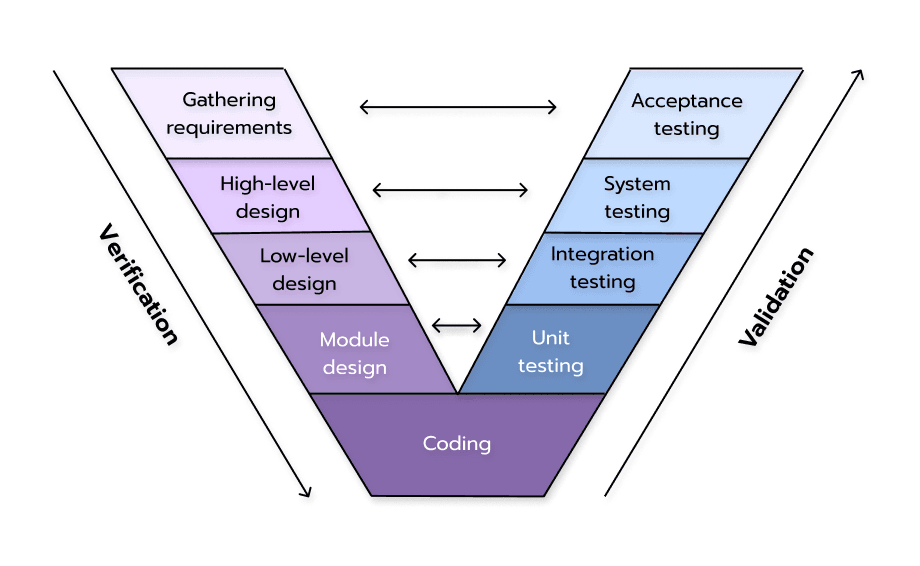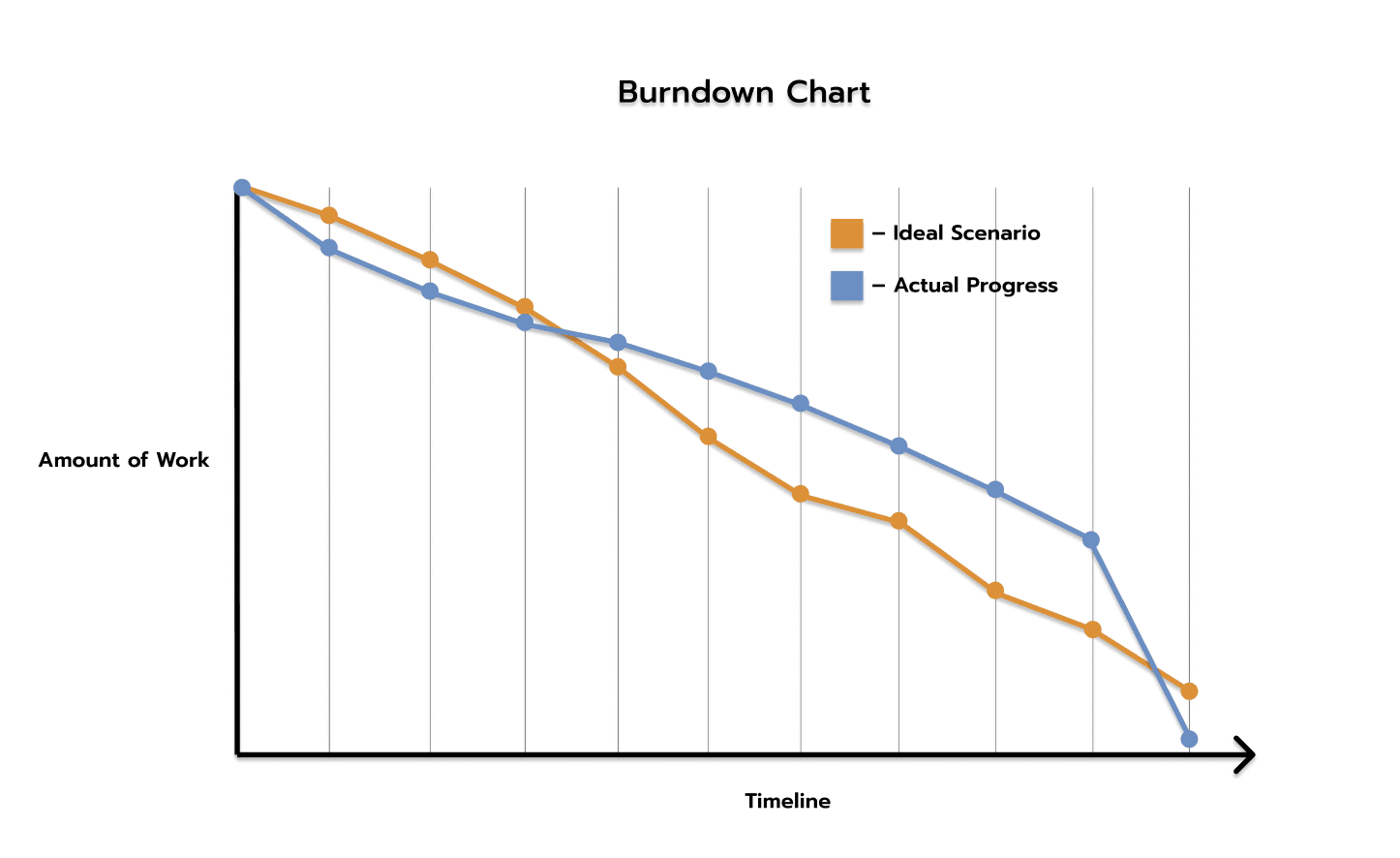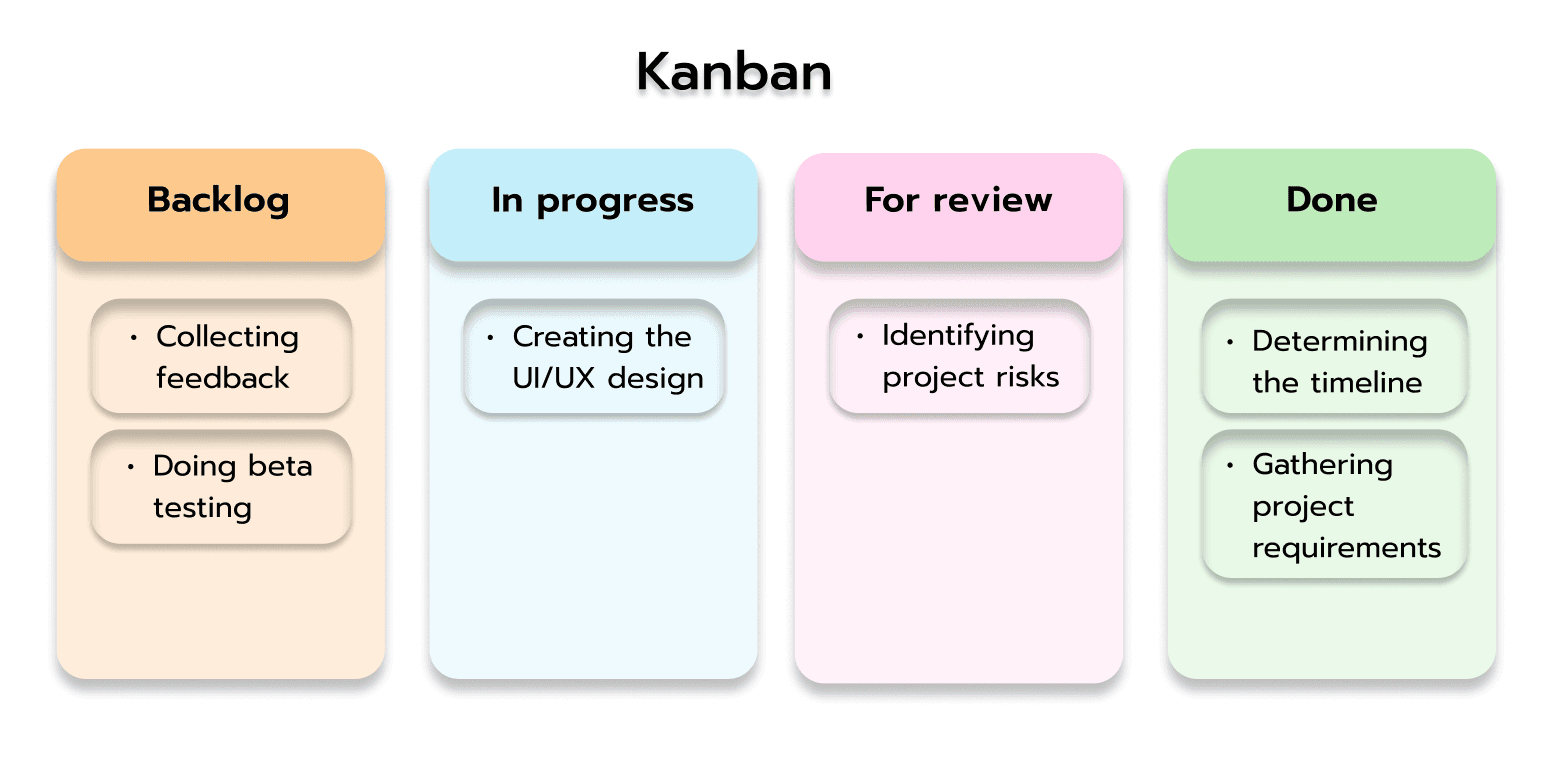
- Mar 16, 2024
- 12 min read
How to Choose the Right Software Development Model for Your Project: Agile vs. Waterfall vs. What?
On Startups

Vitalii Samofal
CTO
Agile is often praised as the best software development approach. Over 70% of US companies use it. Yet, it is not a good choice for many projects. And there are other popular software development models. So, which SW development methodology is the best choice for your project?
In this article, you will learn about the following:
- The process of software development,
- Different models of software development life cycle,
- Agile software development models, and
- How to choose the best software development approach for your project.
The Basics of Software Development Life Cycle (SDLC)
SDLC stands for Software Development Life Cycle. It is the process of developing new software. It has the following stages:
– Planning
Software development processes typically start with planning. During this step, project managers (PMs) create the timeline. They also estimate resources, costs and risks.
– Designing
During this step, experts come together to create the product solution design. It includes architecture diagrams, UI/UX design and other elements. You can read our previous article for details.
– Implementation
Now, developers create software. First, they analyze each aspect of the design. Then, they divide the workload into smaller, more manageable tasks.
– Testing
When the software is ready, it must be thoroughly tested. Experts do different types of testing, including acceptance, stress and beta testing.
– Deployment
Deployment means making the software available for users. Typically, coders create a separate software copy for this. It is called the production environment. This way they can keep working on future updates without disturbing users.
– Maintenance
Experts monitor app performance. They fix bugs and inefficiencies to improve user experience.
These are the general stages of an SDLC. Some stages can be repeated several times, depending on what model of SDLC you choose. The order can also vary.
Waterfall Model
The Waterfall SDLC model is classic. It organizes all stages one by one. When experts complete a stage, they begin the next one. The workflow reminds many people of a waterfall.
This approach has certain pros and cons. The advantages of this software dev process are:
– Well-defined timeline and budget
Are you on a strict deadline or budget? Then, Waterfall development modeling might be a good option. All requirements and tasks are defined from the beginning. So, project managers plan all software development processes in advance. This means that you have a clear timeline. And you know exactly how much each stage will cost you. Unexpected issues might happen. But experts do their best to foresee and mitigate risks.
– Clear outcome
With the Waterfall development life cycle model, you know exactly what you are getting. The result is well-defined and clear. If you know exactly what you need, this is an advantage.
But there are several disadvantages:
– Low flexibility
Once you have started the development process, there is little room for change. Adjustments can be costly and difficult to make. For many coding projects, this is a big disadvantage.
– Slow time to market
With Waterfall, project planning and designing takes a lot of time. So, the overall time to market is longer.
Using Gantt Charts for the Waterfall SW Development Process
Gantt Charts are valuable for Waterfall software-making process. They show tasks on a timeline. The first column lists project tasks. Several other columns have details like task duration or deadline. The top two rows show timeline details. Managers highlight cells where a task aligns with its planned time. Here is a high-level visualization of a Gantt Chart:

You can find free Gantt Chart templates on Microsoft's website.
Nowadays, experts rarely use the waterfall methodology for software development. It is more popular in other industries, like construction.
V model
The V software development model emphasizes testing. It divides the development process into two big parts – validation and verification. Everything that happens before coding and coding itself is a part of validation. Everything else is verification. Look at the image below.

As you can see, both sides have levels. Each verification level has a corresponding validation level (testing stage). The lower the level, the deeper you go into project details.
The first step is requirements gathering. Other SDLC life cycle models assume that this is a part of project initiation or planning. Then, comes design. The V development model divides it into 3 stages: high-level, low-level and module.
First, tech leads create an outline of the software design. Then, they make a detailed version. The module design describes how coders plan to create each individual software element.
When designs are ready, developers start coding. Then, experts test the software. First, they do unit testing. This means testing individual software components to check whether they work as they should. Next comes integration testing. Here, experts check how different software elements work together. The next step is system testing. It is comprehensive and includes:
– functional testing,
– non-functional testing,
– stress testing,
– recovery testing, etc.
The final step is acceptance testing. Here, you show the software to business stakeholders and end-users. They check whether it meets their expectations.
This model is easy to use. It also has clear deliverables and emphasizes testing. This helps to verify that the product follows requirements.
On the other hand, this approach does not offer a clear way to deal with issues. So, similarly to the Waterfall model, fixing mistakes can be difficult. And this model of SDLC is not flexible. So, adjusting requirements is expensive.
Incremental & Iterative Development Model
Experts created this software development model to overcome the disadvantages of linear methodologies, like Waterfall or V. One of its first uses was during NASA's 1960s Project Mercury.
The software development process starts with initial planning and ends with deployment. In between are multiple iterations of:
– further planning,
– design,
– coding,
– testing, and
– evaluation.
With this approach, developers start by creating a minimal product version to which stakeholders can react. It can be a prototype.
The development team collects feedback on the prototype. Then, they make updates. During the second iteration, they fix issues and add more features. After this, they collect feedback again. Then, comes the third iteration and so on. The model is “incremental” since developers add more and more features over time.
Flexibility is the biggest advantage of this software development life cycle model. It is also very customer-focused. Another benefit is that the value is delivered early on.
The downside is that you don’t know the final project scope or cost. The timeline is also uncertain. Developers can provide approximate estimates but those can change.
This software development approach is similar to Agile models. We will discuss them later.
Spiral Model
The spiral software development life cycle model focuses on project risks. This model allows for frequent changes. So, it is well suited for large, complex projects, where risk management is key.
The spiral lifecycle model combines the Waterfall method with the Incremental & Iterative approach. Thus, the development consists of several iterations. But each iteration follows a strict process, similar to Waterfall projects. This process typically includes the following stages:
- Planning,
- Risk analysis,
- Engineering and
- Evaluation.
Look at the image below.

As you can see, a team starts small. At the first iteration, they figure out the initial requirements. Then, they analyze risks and build the first product version. This can be something basic, like a prototype. They evaluate results and plan the next iteration. Following iterations build on the received results. So, the product includes more and more features.
The biggest advantage of the spiral development model is excellent risk management. But it is also expensive and takes a lot of time. So, it is great for large, risky and complicated projects. For small projects, it can be too expensive.
The Rational Unified Process (RUP)
The Rational Unified Process (RUP) is IBM's invention. RUP belongs to iterative development models. Model creators divide the process of software development into 4 phases:
– Inception,
– Elaboration,
– Construction and
– Transition.
Each phase has iterations.
Under this model, experts do a certain amount of each project task at each stage. For example, let’s discuss the task of setting project requirements. Project managers will do the majority of this task during the first two stages. But they might need to make changes during engineering. Let’s take another example – product deployment. In the beginning, we have nothing to deploy. So, about 90% of this task will take place during the last construction iteration and first transition iteration.
Below you can see a RUP hump chart. It shows how much effort experts spend on certain tasks during each project stage.

This software development lifecycle model has several important benefits. First, it incorporates incremental and iterative development. This allows for flexibility and good risk management. Second, you receive regular feedback from stakeholders. All of this focuses the software development process on product quality.
On the other hand, this application development model is complex. Your team will need experienced project managers to do everything correctly. It is better suited for large projects.
The Agile Group Overview
Agile development models are by far the most popular among software developers. This is for a good reason. Compared to Waterfall software modeling, the Agile success rate is 1.5 times higher. Other benefits include:
- 50% faster time to market,
- 2.5 times less defects,
- 60% average revenue growth.
So, what makes Agile models uniquely suited to handle the software development process? Let us discuss three popular Agile software development models:
1. Scrum
Scrum is the most popular Agile development model. Over 60% of Agile users focus on Scrum. And when it comes to Research and Developments, the number is even higher – 83%.
This software development model requires two key managers – the Product Owner and the Scrum Master. The Product Owner is responsible for communicating with clients and other stakeholders. They determine project scope, goals and requirements. Based on those, they create the Product Roadmap.
Then, Product Owners use the Product Roadmap and project requirements to create the Product Backlog.
Scrum Masters organize day-to-day processes. They help development teams be effective and continually improve.
The Scrum development life cycle model is iterative. This means that the software-making process is divided into smaller parts. They are called Sprints. On average a Sprint lasts two weeks. But it can be longer – up to a month.
To track team progress, Scrum Masters hold daily meetings. They are 15 minutes long. After the end of a Sprint, teams hold two meetings – a Sprint Review and a Sprint Retrospective. During a Sprint Review, the team shows progress to the stakeholders. They collect feedback so that they know what to improve. Sprint Retrospectives are internal meetings. Teammates discuss what was good and what they should improve.
A useful tool for Scrum teams is a Burndown Chart. It visualizes the amount of work left against the timeline. Look at the table below.

The vertical axis represents the amount of project work. The horizontal axis is the timeline. As we move further to the right, the lines go down. This is because, the longer we work on a project, the fewer tasks remain.
On our chart, the brown line shows the ideal scenario. This is what happens if everything goes as planned. The blue line represents hypothetical company progress. In our scenario, a team starts strong but then falls behind schedule.
Experts use burndown charts for different software development lifecycle models. But it is especially popular for Scrum.
Overall, Scrum is a very efficient model of the software development life cycle. It is flexible and feedback-driven. And it provides an efficient use of time and resources.
On the other hand, it is not easy to use, especially for large teams. Daily meetings can feel frustrating for team members. There is also a high risk of scope creep. This is a large growth in project scope. This can affect the deadline and overall project success. The focus on quality is also lower, compared to some other application development models.
2. Extreme Programming (XP)
Extreme Programming focuses on flexibility and product quality. The idea is to take the best development practices to the “extreme”. For example, regular code reviews are excellent for quality assurance. But XP takes this to the next level. It promotes pair programming.
Another XP practice is test-first development. This means that QAs write tests in parallel with software development. This allows a team to save time and focus on product requirements.
Like many other software models on our list, XP promotes iterations. So, experts do SW development in small portions. And they seek regular feedback from stakeholders. The methodology emphasizes the role of continuous communication. This improves the quality of the end product. Good communication and thorough testing also reduce project risks.
The XP development life cycle model works best for small teams (up to 12 people).
To sum up, the main benefits of the XP software model are:
– fast time-to-market,
– high quality,
– flexibility, and
– lower risks.
There are several downsides too. First, implementing this software process model can be difficult. Second, practices like pair programming demand more resources. And third, this model requires constant customer involvement. Sometimes, it is not feasible.
3. Kanban
Unlike previous software development methods, Kanban doesn’t have iterations. Instead, it supports a constant flow of work. This development life cycle model promotes the use of Kanban boards.

Digital Kanban boards usually support the drag-and-drop function. Thus, workers can easily move a task from one column to another as needed.
Kanban SW modeling is easy to use. It promotes collaboration. The continued workflow usually provides a good time to market. Also, many companies that use Kanban report a decrease in overhead costs and resource waste. But predicting the right project timeline and budget can be difficult.
Some teams combine Kanban with other methodologies.
Summing Up Different SDLC Models
Now it’s time to compare software development approaches. We identified 7 key advantages that an SDLC model can bring. In the table below you can see how each method performs in those categories.

If you have a small team and project, focus your attention on Scrum, Extreme Programming (XP) and Kanban.
Large teams that handle sizable projects should pay attention to RUP, Incremental & Iterative model and the Spiral method.
Waterfall and the V models work better for large projects. But experts can use them for small projects too. You should use them if:
– you have straightforward requirements that are unlikely to change,
– there is a strict deadline or a budget cap.
Conclusion
There are many methods of software development. Each has certain advantages and downsides. Which method you choose should depend on
– the size of the project and your team,
– whether product requirements are likely to change in the future,
– project risk exposure,
– client priorities (quality, time to market, etc.)
Agile models of the SDLC life cycle are more popular among tech companies. They include Scrum, Kanban and Extreme Programming (XP). But if you work on a large, complicated project, consider RUP, the Incremental & Iterative method and the Spiral lifecycle model. The latter is very good for risk management. Waterfall and the V software development models are good for projects with strict deadlines, budgets and requirements.
FAQ
1. What are the different models of software engineering?
There are many software process models. Examples are Scrum, Extreme Programming, Spiral and Waterfall.
2. Which model is mostly used in software engineering?
Agile software development models are the most popular. They include Scrum, Extreme Programming (XP) and Kanban. Scrum is the most trendy software process model.
3. What are examples of traditional models of SDLC?
Traditional software development methods include V and Waterfall.
4. What is software development?
Software development is a set of activities necessary to create software. And software is a complex set of instructions telling a computer what to do.
5. Which system life cycle models are Agile?
Agile SW development methods are Kanban, Scrum and Extreme Programming (XP).
6. What is software modeling?
Software modeling is the way experts organize the development process for software. Popular software development methods include Scrum, Spiral and RUP.
Subscribe to our blog
Fill out the form below to receive a free consultation and find out how Softkit can help your business grow.